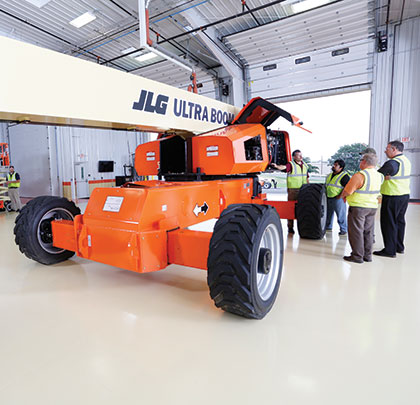As contractors embrace larger, more sophisticated lift and access machines, it becomes increasingly important that their operators and service personnel are properly trained to use and maintain those machines. Proper training also helps to ensure safe and efficient operation of equipment, decreases downtime, increases productivity on the jobsite, and contributes to longer machine life. All of this impacts contractors’ profitability, making it more important than ever before to identify quality training programs—operator training for those who pilot machines and service training for those who maintain them.
The American National Standards Institute (ANSI) writes the standards for aerial work platform (AWP) training programs. Those standards are enforced by the Occupational Safety and Health Administration (OSHA). OSHA writes and enforces telehandler training standards, as well. So the first step is to confirm that a training provider’s program meets these guidelines.
EVALUATE PROVIDERS AND MATERIALS
How do you identify a quality training program? First, consider the reputation of the provider and ask for references from those who have used that provider in the past. If you have the time and resources, it’s also a good idea to observe a class to get a first-hand feel for the program.
Look at the curriculum. Operator training should include safety awareness, inspection instructions for walk-around and function checks, an explanation of machine systems and controls, and application tips. Service technician training should include instruction in electrical and hydraulic print reading, power distribution, mechanical components, troubleshooting, and calibration procedures. Classes should be divided into teachable segments that can be readily digested by students.
In addition to machine-specific courses, look for classes that cover the tools required to service and operate a machine or test equipment, like pressure gauges, hand-held mobile devices, wireless devices, and digital volt meters.
Ask if the program defines a path that takes students from beginner to expert levels. Some programs mandate prerequisites to advance through a program while others allow students to apply experience to prerequisites, providing opportunities to test out of less challenging classes and move on to those that match levels of expertise. A quality curriculum also includes refresher courses to keep technicians abreast of changes in technology.

READ AND DO
OEM training facilities usually combine classroom instruction with hands-on training. Some OEMs take the hands-on experience to the next level, offering facilities for students to operate equipment in a safe environment that recreates a working construction jobsite. The grounds should feature mixed terrain, structures for placing and picking loads, and platform targets that simulate real-world applications.
Some OEMs also offer instruction at customer locations. However, expect these OEMs to challenge you to provide a dedicated space for hands-on training.
In addition to classroom instruction, more sophisticated training programs offer online resources. Distance Learning courses use instructors to facilitate courses electronically over the Internet. Self-paced e-learning delivers instruction electronically without an instructor, enabling students to learn in a time-flexible manner. When considering online training, be sure to ask the provider what types of mobile device support they offer:
- Do they have an app?
- Can participants do distance learning via smartphones and tablets?
Remember, as attractive and convenient as online learning is, it is never a substitute for hands-on training. Blended courses offer the best of both worlds: online learning coupled with face-to-face or classroom instruction and hands-on training.
Simulators, too, are making their way into lift and access training programs. Simulation-based training is particularly well-received by younger students who have grown up playing video games. As with online learning, simulator training can take place off-site, at the convenience of the student and without concern for weather conditions. Simulator training often decreases the learning curve when operators climb into machines for the first time.
FOLLOW THE NUMBERS
Class size is just as important as content. Class sizes can vary, but ratios are important. For example, the ideal technician training class should have a student-to-machine ratio of 1:1, with a maximum of 3:1. The ratio is not as critical for operator training because every student must operate a machine sometime during the class. Look for a course that offers a minimum of half classroom instruction and the remaining half of the course time dedicated to hands-on instruction.
The instructor-to-student ratio is also important. For technician training, one instructor should never have more than 15 students in a class. This ratio shrinks to 1:12 for operator training.
ADDITIONAL CONSIDERATIONS
These questions are also important:
- Are multi-language training platforms available?
- Are train-the-trainer programs available?
- Are there refresher courses or updates available?
- Does the course require special software or other IT support?
- How frequently are courses offered?
- Are courses available at easily accessible locations?
TRAIN, TRAIN, AND TRAIN AGAIN
Think of training as an ongoing process that reinforces safe operating practices and helps ensure jobsite productivity. Thus, it impacts the bottom line. Investing in your people ensures that the impact is a positive one. ■
About The Author: Richard (Rick) Smith is senior director, product training, at JLG Industries, Inc. He is responsible for all aspects of JLG® product training globally, including service, sales, and Train-the-Trainer programs. He oversees curricula design, program development, and program implementation. In addition, he manages training at three JLG facilities and several partner locations in the U.S.
_________________________________________________________________________
Modern Contractor Solutions, June 2015
Did you enjoy this article?
Subscribe to the FREE Digital Edition of Modern Contractor Solutions magazine.



